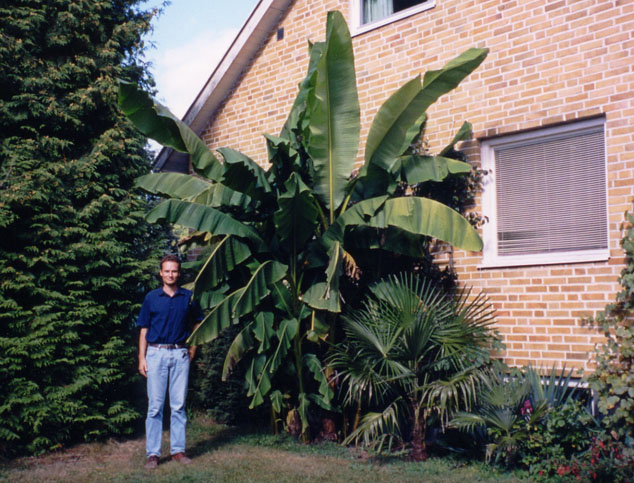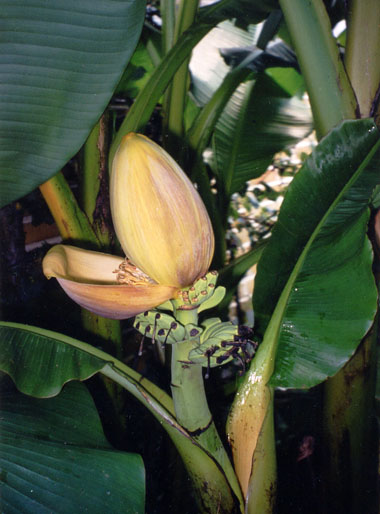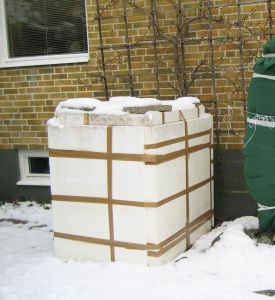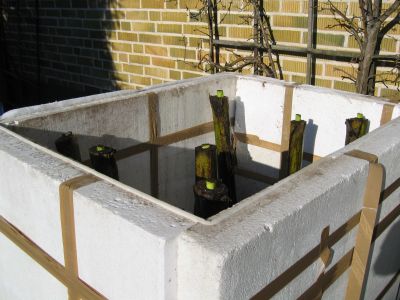Bananas for Scandinavia
If you want to create a "tropical" effect in a garden, then banana plants are completely unbeatable. There is mainly just one banana species that may be considered for Scandinavia; Musa basjoo (Japanese Fibre Banana). It looks exactly as a banana plant is supposed to do but unfortunately it produces no edible bananas – at best they are small and full of kernels. It is quite hard to get it to blossom in Scandinavia, if it is planted outdoors in the ground all year round, but it is not entirely impossible.

Musa basjoo in Ängelholm, Sweden, summer 2002 (planted 1996).

Musa basjoo flower stem in Ängelholm, Sweden, summer 2002. It is required that the pseudo-stem has survived several years before it will bloom.
Unfortunately, banana plants are just a pleasure for the summer months in Scandinavia. Even though the plants can be overwintered outdoors, they are only beautiful in the summer. The leaves cannot withstand much frost but the underground tubers will survive the winter and produce new pseudostems if the ground is covered well. The tubers can perhaps withstand some ground freezing but it is more safe to cover the ground in the winter. It is also possible to overwinter the pseudostems (which actually consist of the leaf stalks) if they are well protected. It is hardly possible to save the leaves, unless the plant is dug up and brought into a greenhouse.
One way to protect banana plants in the winter that works for me well is to cut off the leaves and build a protection of 10 centimetres thick sheets of expanded polystyrene around the pseudostems. Inside the protection, around the stems, I fill up with balls of Leca (light expanded clay aggregate). I do not fill up all the way since this would require large quantities of Leca balls, which would be quite expensive. The part of the pseudostems that is protected by the Leca will probably not freeze even in very cold winters. The parts that are unprotected by the Leca may be damaged in very cold weather but even if the outer parts of the stems will freeze, the inner parts are normally undamaged. It is probably good to open the protection after cold periods and cut off damaged parts of the stems in order to prevent rotting. The more of the stems that will survive the winter, the better start the banana plant will get the next summer and the bigger it will get. Unfortunately, this protection was not enough during the very severe winter of 2010–2011, and the banana plant froze to death. The problem was probably in part that the ground was not sufficiently covered around the protection and the snow cover was too thin so that frost could penetrate from the sides. still, the protection worked surprisingly well for many years and the plant did bloom three times. This kind of protection would hardly be enough even during normal winters in a colder climate, and should probably be supplemented with some form of active warming.
Musa basjoo may grow to 4–6 metres in warm climates, but it is not likely that it will reach that size in Scandinavia if it is planted in the ground all year round. If it is overwintered in a greenhouse it may grow larger. It is necessary to water and fertilize generously throughout the summer to make it grow as fast as possible. The banana plant should preferably be planted on a sunny and wind-sheltered location. It is always sad to see the leaves be broken, snapped and torn by the wind.
There are a few selected varieties of Musa basjoo which are allegedly hardier than the species in general, such as M. basjoo 'Sapporo' from the city of Sapporo on the northern Japanese island of Hokkaido. M. basjoo 'Sakhalin' is a smaller, sturdier and more broadleaved cultivar purportedly from the Russian island of Sakhalin north of Japan. M. basjoo is obviously not indigenous to these places, and these are of course only cultivated varieties. The variety sold under the name M. basjoo 'Red' or 'Rubra', is probably no real M. basjoo, or could possibly be a hybrid with M. basjoo. It is probably not as cold hardy as the species in general.


Winter protection of Musa basjoo, January 2005, and a close-up picture without the top cover in the beginning of March 2005. This protection was unfortunately not enough during the very severe winter of 2010–2011, and the banana plant froze to death.
There are also other species of banana (Musa), which are relatively hardy, even though they can hardly compete with Musa basjoo, perhaps even species that could produce edible fruits (although no fruits should be expected in Scandinavia). An interesting species that is even more beautiful than M. basjoo is M. sikkimensis (syn. M. hookeri) from the Himalayas. It has dark green leaves with a tint of red. Unfortunately, it seems like M. sikkimensis is not as hardy as M. basjoo, although it is sometimes claimed to be. M. itinerans is reported to have survived in the ground in Denmark and should therefore be interesting to test. Some of the plants that have been sold under the name M. itinerans may in fact be M. yunnanensis, which also should be quite cold hardy. Another relative within the banana family (Musaceae) that could be interesting to test is Ensete lasiocarpum (syn. Musella lasiocarpa). It is also not quite as hardy as Musa basjoo and it grows more slowly. Also Ensete glaucum has a reputation of potential hardiness. Since it is a very widespread species in Southeast Asia, probably only a few varieties are reasonably hardy.
Banana plants belong to the plant order Zingiberales where there are other hardy species. Different species and varieties of Canna, such as C. indica, have become popular in summer plantings outdoors. Normally it is recommended that the tubers are dug up in the autumn and stored in a cool place indoors in the winter, but it should be possible to overwinter the tubers in the ground if the ground is well covered. Within the ginger family Zingiberaceae there are many genera with species that can survive in the ground. Especially within the genus Hedychium there are several hardy species, such as H. forrestii. Even Cautleya gracilis (syn. Cautleya lutea) has a chance to survive with proper winter coverage.
Links
The following garden centres sell Musa basjoo by mail order. No special permits or certificates are required to buy plants within the European Union.
Other links:
- The Musaceae.
- Stokes Tropicals
- Mulu Nurseries
- TropicaFlore
- Pépinières Penninckx
- The Banana Tree
- Musella - Wikipedia, the free encyclopedia
- Musa basjoo in Flora of China
- Musella lasiocarpa in Flora of China
- Cautleya gracilis in Flora of China
- Hedychium forrestii in Flora of China
- Canna indica in Tropicos
- Discussion forum: Banana Forum
If you have any comments or suggestions, e-mail me:
